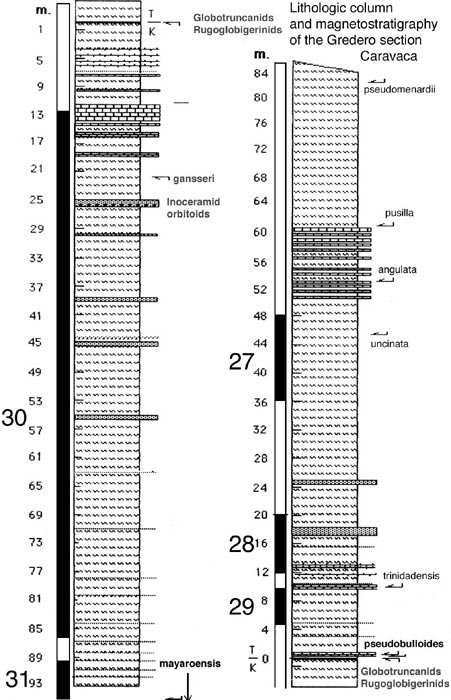 |
Two mastersprojects of
C. Hermes, measured the Gredero section in detail. [7] subdivided the
Paleocene, and his student [8] recognized the presence of the P. eugubina
Zone, but analysed only three samples from the K/T interval. Hermes
(pers comm) and [8] mentioned a 10 clayinterval at the K/T boundary,
but paid no further attention. [9] (fig 3) analysed the K/T interval
in further detail, every cm in the K/T transitional interval, including
the boundary clay (BCL). He found the red laminae (sample sm75-503),
that most people believe it is the Chicxulub impact ejecta layer. A
new biozone was established [9] between the top of the Maastrichtian
and the base of the G. eugubina Zone; the G. cretacea or
the P0 zone, whose type locality therefore is in the Gredero section.
A paleomagnetic analysis of the Gredero section was performed by G.
Brunsmann (Univ Amsterdam) [10] (fig4). The magnetostratigraphy of
the uppermost 100m of the Maastrichtian and the basal 70m of the Paleocene
showed magnetochrons C31 to C27, very well comparable to the classic
section at Gubbio, and the Agost section 100km further east [11] ).
The same sample set was subjected to analyses by neutron activation
in 1977 at Delft University. The results, obtained spring 1978, showed
a strongly anomalous content of Cr, Ni, As, Sb, Zn in sample Sm75-503,
15-250 times enriched opposite background values, but not (yet) the
iridium anomaly [12] . Nickel of course is often associated with Ni-iron
meteorites, and values of 2000ppm (of sm75-503) are rare anywhere on
earth. Around the same time, the Alvarez group published the find
of anomalous iridium in Gubbio at the 1978 AGU fall meeting, by a similar,
but more sensitive neutron activation analysis. Jan Hertogen of Gent
university showed in 1979 the presence of anomalous Ir in Gredero as
well, particularly in sample 75-503.
The extremely short extinction interval <0.5cm), already called
for a catastrophic extinction because in the preceding >100m thick
interval very little happened in terms of planktic foraminiferal changes
(only G. gansseri disappeared 10 m below K/T). The strong adaptive
radiation of foraminifers within the first 50cm above the boundary
clay, further strengthened a catastrophic cause. The iridium anomaly,
by pointing at a large impact event, provided a plausible cause for
the catastrophe. |
 |





